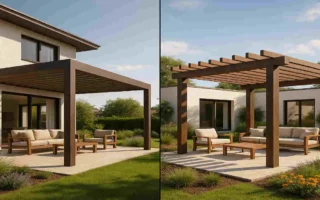A metal carport is a versatile and practical addition to any home, providing protection for vehicles, outdoor equipment, and even serving as an extended living space. Attaching a metal carport directly to your house offers the added benefits of convenience, seamless integration with your home’s structure, and enhanced protection from the elements.
Understanding Metal Carports

Metal carports come in various styles and sizes, ranging from simple, freestanding structures to more complex, attached designs. The most common types of metal carports include:
- Single-slope carports: A simple, one-sided sloped roof that attaches to your house on one end.
- Gable-roof carports: A two-sided, peaked roof that mimics the look of a traditional house roof.
- Flat-roof carports: A modern, minimalist design with a flat roof that provides a clean, streamlined appearance.
Metal carports offer several advantages over other materials, including wood and vinyl. They are durable, low-maintenance, and resistant to fire, rot, and pests. Additionally, metal carports are often more affordable than other options, making them an attractive choice for budget-conscious homeowners.
Planning Your Metal Carport Attached to a House
Before you begin building your metal carport, it’s crucial to plan the project carefully. Start by assessing the available space and site conditions around your house. Consider factors such as:
- The location of doors, windows, and other features on your house’s exterior
- The slope and stability of the ground where you plan to build the carport
- The proximity to property lines, easements, or other structures
Next, check your local building codes and permit requirements. Many jurisdictions have specific regulations governing the construction of carports, including size limitations, setback distances, and anchoring requirements. Failing to comply with these codes could result in fines or even the need to remove the carport altogether.
When choosing the size and design of your metal carport, consider your specific needs and the overall aesthetic of your house. A well-designed carport should complement your home’s architecture and provide ample space for your vehicles or other intended uses.
Finally, create a materials and tools list for the project, and develop a budget estimate. Some of the essential items you’ll need include:
- Metal framing components (posts, beams, trusses)
- Metal roofing panels
- Concrete mix for footings
- Anchoring hardware (brackets, bolts, screws)
- Power tools (drill, saw, level)
- Safety equipment (gloves, goggles, hard hat)
Step-by-Step Guide: How to Build a Metal Carport Attached to a House
Preparing the Site
Begin by clearing the area where you plan to build the carport, removing any vegetation, rocks, or debris. Use a level to ensure the ground is level, and make any necessary adjustments by adding or removing soil as needed.
Next, mark the layout of the carport using stakes and string, ensuring that the dimensions match your planned design and comply with local building codes.
Install concrete footings or a foundation to provide a stable base for the carport. This typically involves digging holes at each post location, placing a metal post anchor, and filling the hole with concrete. Allow the concrete to cure fully before proceeding.
Building the Frame
Select the appropriate metal framing components for your carport, such as steel or aluminum posts, beams, and trusses. The specific components will depend on the size and design of your carport.
Erect the vertical posts, starting with those that will attach to your house. Secure these posts to the house using appropriate anchoring methods (discussed in the next section). Then, install the posts on the outer edge of the carport, ensuring they are plumb and securely attached to the foundation.
Once all posts are in place, connect them with horizontal beams and roof trusses, following the design of your carport. Use bolts or screws to create sturdy connections between the framing components.
Attaching the Carport to the House
Properly anchoring the carport to your house is critical for stability and safety. The specific method will depend on your house’s exterior material:
- Siding: Remove a section of siding where the carport will attach, and secure a ledger board directly to the house’s framing using lag bolts. Attach the carport’s framing to the ledger board.
- Brick or masonry: Use masonry anchors to secure a ledger board to the brick or concrete wall. Then, attach the carport framing to the ledger board.
To weatherproof the connection between the carport and the house, use flashing and sealant to prevent water infiltration. Ensure the flashing is installed under the house’s siding or roof edge and over the carport’s framing.
Installing the Roof Panels
Choose from various metal roofing panel options, such as corrugated steel, standing seam, or ribbed panels. Consider factors like durability, appearance, and cost when making your selection.
Install the roofing panels according to the manufacturer’s instructions, starting at the lower edge of the roof and working your way up. Ensure proper overlap between panels to prevent leaks, and use appropriate fasteners to secure the panels to the framing.
Apply sealant or weatherstripping along the edges of the roof panels to further protect against water infiltration.
Adding Finishing Touches
To enhance the appearance and longevity of your metal carport, consider painting or powder coating the framing components. This will not only improve the carport’s visual appeal but also protect the metal from rust and corrosion.
Optional additions to your carport include:
- Gutters and downspouts to manage water runoff
- Side panels or walls for added protection and privacy
- Lighting fixtures for convenience and safety
- Storage solutions, such as shelves or cabinets, can be used to maximize the carport’s functionality.
Maintenance Tips for Your Metal Carport
To keep your metal carport in top condition, perform routine inspections and cleaning. Look for any signs of damage, rust, or loose connections, and address these issues promptly.
Regularly wash the carport with a mild detergent and water to remove dirt and debris. Apply a rust-inhibiting paint or sealant to any areas that show signs of corrosion.
If you notice any minor damage, such as small holes or dents in the roofing panels, repair them quickly to prevent further deterioration. Many metal roofing manufacturers offer repair kits or sealants specifically designed for their products.
Common Mistakes to Avoid When Building a Metal Carport Attached to a House

To ensure a successful and long-lasting carport installation, avoid these common mistakes:
- Poor site preparation: Failing to create a level and stable foundation can lead to structural issues and premature wear and tear.
- Inadequate anchoring to the house: Improperly securing the carport to your home can result in safety hazards and potential damage to both structures.
- Ignoring local regulations or permits can lead to fines, legal issues, and even the need to remove the carport.
Benefits of DIY Metal Carport Construction vs. Hiring a Professional
Building a metal carport attached to your exetrior house as a DIY project offers several benefits:
- Cost savings: By purchasing materials and performing the labor yourself, you can significantly reduce the overall project cost.
- Personal satisfaction: Successfully completing a DIY carport project can provide a sense of pride and accomplishment.
- Customization: When building the carport yourself, you have complete control over the design, materials, and features, allowing you to create a structure that perfectly suits your needs and preferences.
However, there are situations where hiring a professional contractor may be the better choice:
- If you lack the necessary skills, tools, or time to complete the project safely and effectively
- When dealing with complex site conditions or building requirements that demand expert knowledge
- If you want to ensure the carport is built to the highest standards and complies with all local regulations




